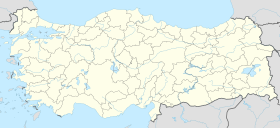Karahan Tepe
 | |
| Location | Karahan Tepe, Şanlıurfa Province, Turkey |
|---|---|
| Coordinates | 37°05′31″N 39°18′05″E / 37.09194°N 39.30139°E |
| History | |
| Founded | Pre-10th millennium BC |
| Periods | Pre-Pottery Neolithic A to B |
Karahantepe is an archaeological site in Şanlıurfa Province in Turkey. The site is close to Göbekli Tepe and archaeologists have also uncovered T-shaped stelae there. According to Daily Sabah, "The excavations have uncovered 250 obelisks featuring animal figures to date."[1]
The site is located near Yağmurlu and roughly 35 kilometers east of Göbekli Tepe, which is often called its sister site.[citation needed] It is part of the Göbeklitepe Culture and Karahantepe Excavations project. The area is known as “Keçilitepe” by local people.[2]
History
The ancient structures at Karahan Tepe were discovered in 1997 by "researchers near the Kargalı neighborhood in the Tek Tek Mountains National Park."[3]
Necmi Karul, an archeologist at Istanbul University, told Anadolu Agency in 2019, “Last year, excavation work restarted in Karahantepe [Kectepe] – around 60 km from where Göbeklitepe is located – and we encountered traces of special structures, obelisks, animal sculptures, and descriptions as well as similar symbolism”.[4] The site was filled with dirt and rubble at some point, preserving T-topped columns carved into bedrock.[1]
References
- ^ Agency, Demirören News (2020-11-27). "New Karahantepe settlement may be older than Göbeklitepe". Daily Sabah. Retrieved 2020-12-07.
- ^ "Karahantepe on way to be new face of Turkey". Hürriyet Daily News. Retrieved 2020-12-07.
- ^ "Karahantepe excavations start in Şanlıurfa". Hürriyet Daily News. Retrieved 2020-12-07.
- ^ . The site was preserved in part by being filled in with dirt and rubble at some point preserving columns and carvings such as a large human face.Kazanci, Handan (8 March 2020). "Turkey: Conservation, not excavation, focus in Gobeklitepe". Anadolu Agency.
{{cite web}}: CS1 maint: url-status (link)
- Tells (archaeology)
- 1997 archaeological discoveries
- Archaeological sites in Southeastern Anatolia
- Archaeological sites of prehistoric Anatolia
- Buildings and structures in Şanlıurfa Province
- History of Şanlıurfa Province
- Lost ancient cities and towns
- Megalithic monuments in the Middle East
- Neolithic sites of Asia
- Prehistoric art in Turkey
- Prehistoric Anatolia
- Archaeology stubs



